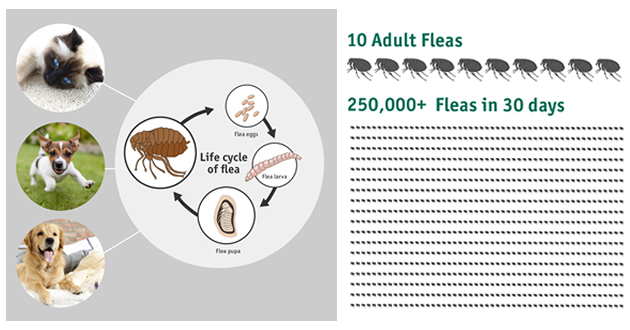Do you struggle to keep your pet flea-free?
Fleas thrive in summer, and in our beautiful Australian climate, they remain active all year round, making our pets itchy and uncomfortable. Fleas are the number one cause of skin allergies in cats and dogs and can cause other health problems such as bacterial infections, anemia and tapeworm infections.
Read on to find out more about the symptoms of fleas, the flea lifecycle and how to protect and treat your cat or dog.
What are fleas?
Fleas are tiny, dark brown parasitic insects that infest the coats and skin of pets.
How do I know if my dog or cat has fleas?
One of the first signs of a flea infestation is that your pet will be scratching and seem quite irritated, especially around the base of the tail or backs of their hind legs. For a closer look, part your pet’s fur and see whether you can identify adult fleas on the skin. However, as fleas can be quite elusive, it is more likely that you will find flea dirt (flea faeces), which looks similar to small black specks of grit, similar to finely ground pepper.
So, how do pets get fleas?
Flea eggs and pupae can remain dormant for long periods of time under a variety of conditions. They can lay dormant in the garden, on your carpet, and on your furniture until the conditions are favourable enough for them to hatch. From there, they need to find a host on which to feed, which can include human members of the family. Remember, they can jump up to 150 times their own length!
The answer to a flea-free pet is simple – prevention all year round. Remember that fleas breed at a phenomenal rate – ten adult fleas can multiply to more than 250,000 in only 30 days!
Why do fleas spread so quickly?
Fleas breed at an enormous rate. The fleas you see on your dog represent only 5-10% of the fleas within their environment. The rest of the population is represented in the egg and larval stages found in your carpets, furniture, bedding, and garden.
The life cycle of a flea

- 5% of fleas live in the environment as an adult.
- 95% of fleas live as eggs, larvae, or pupae.
- For effective flea control, it is essential to break the lifecycle in the environment.
Adult Fleas – jump onto your dog or cat, feed on their blood, and start laying eggs.
Eggs – one female lays an average of 30 eggs daily, which drop off into carpets and bedding before hatching.
Larvae – the hatched eggs release larvae that move away from light, deeper into carpets and under furniture before developing into pupae. The larvae feed on organic debris and, at this stage, can consume tapeworm eggs, allowing them to become an intermediate host for the development of tapeworms.
This lifecycle can take as little as two to three weeks and as long as 12 months. To rid your pet and household of fleas, you must break this cycle. Prevention is the key to flea control. Many different flea products are available to purchase, so choosing the right one for your pet’s type and age is essential. Speak to your Greencross Vet to help you pick the right products.
Why is it important to treat and prevent fleas?
Fleas are the number one cause of skin disease in pets and can cause problems ranging from simple itchiness to weeping sores, scaly skin, and infection. Some animals are allergic to flea bites (a condition known as flea allergy dermatitis), where one bite sets off an auto-immune reaction. All skin conditions require veterinary treatment.
How do I protect my pet from fleas?
Recent innovations in flea control have made toxic, expensive, and hard-to-use products a thing of the past. When undertaking flea control, you must consider the various stages of the life cycle. In severe infestations, it is sometimes necessary to treat the pet and the environment.
Regular grooming helps you spot flea problems before they become infestations. If you find any signs of fleas, act quickly to prevent them from spreading.
How do I treat my pet?
When treating your pet for fleas, ensure you speak to your local Greencross Vets pet care team about the best products to suit your pet’s needs. These may include a flea comb and preventative products such as a tasty treat, chew, spot-on treatment, or collar. Treating all pets in the household and their environment is vital to reducing the chances of flea eggs and pupae in and around your home.
If you are using a flea rinse on your dog, do not wash with soap or detergent-based shampoo before or after the rinse unless specifically recommended on the product label — you will reduce the effectiveness of the treatment. Measure the rinse accurately and groom well into the dog’s coat using a large sponge. All in-contact animals should be treated at the same time with appropriate products. Ensure you use dog products for dogs and cat products for cats.
Products to rid fleas on your pet
- The latest ‘spot on’ applications are easy to use and last three to four weeks.
- Oral tablets provide instant relief and a quick knockdown.
- Monthly tablets work as an effective birth control for fleas, interrupting the life cycle.
- Shampoos and rinses kill fleas living on your pet but offer no residual protection.
Control the environment
Adopt the following strategies to bring flea infestations under control:
- Vacuum the carpet two to three times a week to remove eggs.
- Wash pet bedding weekly.
- Spray the house, kennels, and yard with an adult flea killer weekly.
- Fog the house to prevent larvae from developing (speak to a professional).
Keeping an eye on your pet’s skin
If your pet is scratching or has skin damage, it is best to have them checked by a vet. Our Greencross veterinary team are fully trained in flea management and can assist you in choosing the product most suitable for your pet.
For more information on the best flea solution for your pet, talk to your local Greencross Vets team today.

 Greencross Vets
Greencross Vets 









